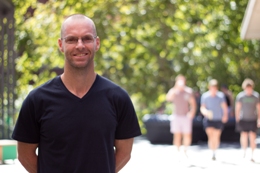16 April 2015
 A University of South Australia research project using advanced 3D body scanning could help the Royal Australian Navy optimise working environments on ships and better design uniforms and specialist clothing.
A University of South Australia research project using advanced 3D body scanning could help the Royal Australian Navy optimise working environments on ships and better design uniforms and specialist clothing.
UniSA and the Defence Science Technology Organisation (DSTO) are collaborating under the Defence Science Partnerships Program, which has recruited 26 Australian universities since it was established by DSTO in 2014.
The $1 million research project run by UniSA’s School of Health Sciences is using digital anthropometry to measure body dimensions and proportions of 1500 personnel to assist in customising internal specifications of submarines and ships.
The population is generally taller and wider than they were 30 years ago and lead researcher and senior lecturer Dr Grant Tomkinson says the data will inform decisions around working environments such as the height and width of doorways and the length and width of bunks in submarines.
“Submarines are built to last across many generations, 20 to 30 years or more,” Dr Tomkinson says.
“So while we have a piece of machinery that can last for many decades, the average sailor – just like the average person – is changing over time. People are now on average about an inch or so taller, and a bit wider, than they were 30 years ago.
“It is a way of surveying body size and shape for the Navy which will give them some good predictions on how they might change in the future, and then how their equipment and machines should look.”
Dr Tomkinson and colleague Dr Nathan Daniell are working with a team of postgraduate and undergraduate students to measure 1500 Navy personnel based in New South Wales and Western Australia.
“Our survey of body size and shape uses both traditional methods and a digital approach,” Dr Tomkinson says.
“We use a 3D whole-body scanner, which is like stepping into a large changing room and 15 seconds later we get a 3D image of your body that we can extract measurements from at a later stage.
“It captures about half a million data points on the surface of the body and then we can measure dimensions like waist circumference without needing the person again in the future.”
Dr Tomkinson says the team is contracted to take about 90 measurements of the body, including standard measurements like circumferences, heights, lengths and breadths of the arms, legs and torso.
“We’re also doing some customised measurements such as eye spacing to help viewing through periscopes, head measurements for helmet fit, hand length to navigate controls, and the length from the knees to the buttocks to help with seating size,” Dr Tomkinson says.
“If you’re not fitting in your environment well, you’re not going to be as efficient and it will create more stress and strain. You’re more likely to have more niggles, and those niggles can lead to injuries. The main driver behind this research is ergonomics – to optimise the fit of the person to the environment, help them work better and ultimately build a stronger defence force.”
Captain (Dr) Simon Reay Atkinson said the Royal Australian Navy and the Australian Defence Test & Evaluation Organisation (ADTEO) are collaborating with UniSA and DSTO in the research to solve real-world Defence problems.
“We live in a world in which we can no longer isolate the information from the technological from the human. In this world we need to better fit our people to the work spaces and organisations they occupy, such as operations rooms, so they can solve pressing problems, healthily and over prolonged periods away from Base Ports,” Captain Atkinson says.
DSTO and UniSA have had a strong working relationship since 2004 and this project has developed broader links between UniSA and Defence.
Contact for interview: Dr Grant Tomkinson office 8302 1407 mobile 0478 473 062 email grant.tomkinson@unisa.edu.au
Media contact: Kelly Stone office 8302 0963 mobile 0417 861 832 email Kelly.stone@unisa.edu.au



